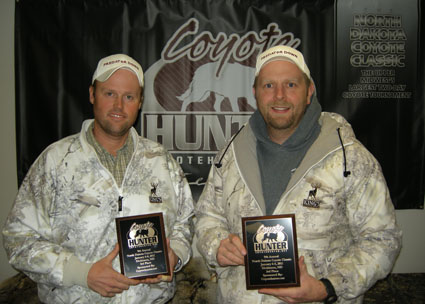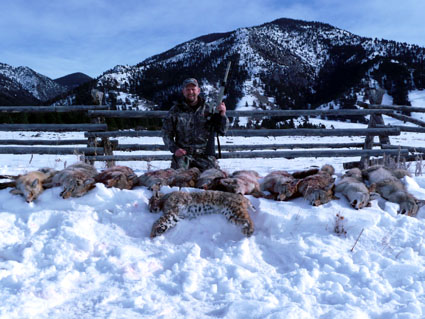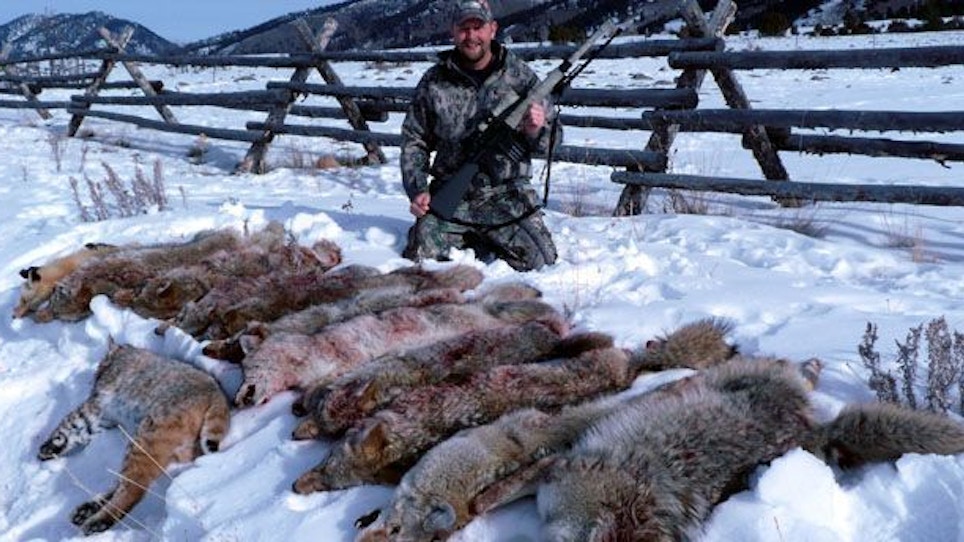We watched the clock intently and forced ourselves to drive the speed limit as we headed for final check-in of the 9th annual North Dakota Coyote Classic (NDCC). Did we kill enough coyotes to win? Did other teams struggle with strong winds today? Questions raced through our minds as we tried to predict the outcome. Anyone who has participated in a large calling contest knows how nerve-racking this can be. Needless to say we didn't have any fingernails left.
 The author and his hunting partner Travis Osmond after the 9th annual North Dakota Coyote Classic. |
The NDCC is the largest two-day calling contest in the upper Midwest and takes place in Dickinson, N.D. The hunt is held in January so weather conditions are difficult to say the least. This year snow was so deep that traveling to a stand without snowshoes was almost impossible. This was our first year to compete in the NDCC and our first time ever calling coyotes in North Dakota. My hunting partner Travis Osmond and I killed 7 coyotes in two days, enough to bring home the third place trophy. First and second place teams killed 8. We needed just one more.
We're frequently asked how we find coyotes and compete in areas that we've never hunted. You might be surprised that we spend more time scouting than hunting. Over the years we've learned some scouting techniques that help us find and kill coyotes. Of course, these tactics work whether we're hunting in a contest or just looking for a great day of calling. There are several ways to scout for coyotes, but some are absolutely more effective than others.
General Coyote Scouting
During my predator calling seminars I frequently ask coyote hunters how they scout. 90 percent of the time I get one of two answers. Either they don't scout at all, or they return to areas where they saw coyotes during big-game season. Scouting is imperative if you want to consistently call coyotes. You can't call them if you don't know where they are.
There are a couple of general scouting methods that are effective. I call it "general" scouting because you have a general idea where they are, but not an exact location. I like to travel back-roads a day or two after a fresh snow storm and look for tracks. Fresh sign proves there are coyotes in an area. Hungry coyotes can really cover country so tracks aren't the best indicator of coyote numbers. Also, every coyote won’t cross every road you travel. Talking with landowners is another good method. They frequently see coyotes in their area and hear them at night. If you're hunting a new area, locals can typically get you started in the right direction.
Advanced Coyote Scouting
Now let’s talk about a scouting method that "separates the men from the boys." I believe in doing everything I can to maximize opportunity at every stand. How great would it be to "KNOW" there are coyotes at every stand? If you're really serious about calling more coyotes, give this method a try.
I spend several hours the night and morning before my hunt locating coyotes. I typically start around 10 p.m. and locate coyotes until daylight. My objective is to get the coyotes howling back at me so I can determine their location and quantity. I typically use either interrogation howls with a mouth call, or a pack of coyotes howling with an electronic caller. A siren also works. Coyotes don't always respond to the first sequence of howls. I typically howl for 30 seconds then listen for 1 minute. I repeat this sequence 3 or 4 times then move to the next location.
 The author after a great weekend of January coyote hunting in Eastern Montana. |
Mark Their Location
Use a map, GPS unit, landmarks, or even mile markers to keep track of where you hear them. The more familiar you are with the area the easier it is to accurately identify their location. This information will help you select the best stand locations for the next day.
Keep Track of Numbers
Keep track of how many coyotes respond at every location. If you locate too many coyotes for one day of calling, work the areas with the most coyotes first. This increases your odds of taking multiple coyotes on a stand.
What Does a Coyote's Sound Tell You?
Pay careful attention to their sound. In the late winter months I use different sounds for different coyotes. If you're calling a dominant male start your stand with a young interrogation howl or even a young aggressive howl to set off his territorial instincts. Young coyotes might respond better to distress sounds or bird sounds. A lone male will likely respond to a female invitation howl. Knowing "who" you're calling will help determine the best stand sequence.
This information changes the game. It allows you to accurately evaluate what works and what does not. You don't have to play the guessing game anymore. If they're not responding you need to change your calling sequence.
You'll Reap What You Sow
I don’t know anyone who calls coyotes consistently without working for it. Just like everything else in life, you'll get out exactly what you put in. Sure you might get lucky from time to time, but consistency requires dedication and work. Our finish at the NDCC in North Dakota was a result of four days of scouting. Seems silly to scout four days and hunt two, or does it?
About The Author
Dustin has been calling predators for nearly 20 years. He has competed in coyote calling contests around the Western U.S. for more than a dozen years and has consistently excelled including many wins and top finishes. He enjoys sharing his knowledge of predator hunting with others through calling seminars and magazine articles. To learn more about Dustin or the equipment he uses visit www.predatordown.com.






